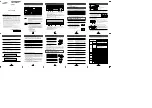
3.3 Track-at-Once, Disc-at-Once, Session-at Once and Packet
Writing
There are four basic methods of writing to a compact disc: Track-at-Once, Disc-at-Once, Session-at-
Once and Packet Writing. These are independent of both the physical format and the file system in
which a disc may be written.
Track-at-Once
In Track-at-Once recording, the recording laser is turned off after each track is finished, and turned on
again when a new track must be written, even if several tracks are being written in a single recording
operation.
Tracks recorded in Track-at-Once mode are separated by gaps. If a data track is followed by an audio
track, the gap is 2 or 3 seconds. The gap between audio tracks is usually 2 seconds.
The software can do nothing to suppress or reduce the gap, unless both recorder and software
support variable-gap Track-at-Once. This feature allows you to set the size of the gap, from near zero
(2 sectors, or 2/75 of a second) to 8 seconds, before each audio track on an audio disc.
Disc-at-Once
In Disc-at-Once recording, one or more tracks are recorded, without turning off the recording laser,
until the disc is closed. Disc-at-Once recording requires a blank disc, and cannot be used for
MultiSession recording.
Disc-at-Once is primarily needed for recording audio discs with a variable (or no) gap between tracks
(for example, live concerts).
Session-at-Once (NOT supported by all drive models!!)
Session-at-Once is used primarily for CD Extra. In Session-at-Once recording, a first session
containing multiple audio tracks is recorded in a single pass, then the laser is turned off, but the disc is
not closed. Then a second (data) session is written and closed.
Packet Writing
Packet writing is a method of writing data on a CD in small increments, in accordance with the
industry-standard UDF specification. Not every CD-ROM drive can read packet-written discs. Packet
writing is a feature that must be built into the recorder's hardware. It cannot be implemented by a
firmware upgrade.
Two kinds of packets can be written: fixed-length and variable-length. Fixed-length packets are more
suitable for CD-RW in order to support random erase, because it would be cumbersome and slow to
keep track of a large, constantly-changing file system if the packets were not written in fixed locations.
The drawback is that these fixed packets, with a length of 64 kilobytes, take up a great deal of
overhead space on the disc. The normal data capacity of a CD-RW disc formatted for writing in fixed-
length packets is about 500 megabytes.
Variable-length packets save space, because the size of the packet can vary with the size of the data
being written. This is more useful when writing to a standard CD-R disc, because these are write-once
media, and it is not necessary to track and allocate free space when files are 'erased'. (NOTE: On CD-
R discs, files cannot actually be erased, but can be made invisible.)
For more info visit:
www.roxio.com
or
www.nero.com
Содержание JR12CDRWK/00
Страница 1: ......
Страница 225: ...WORLD WIDE GUARANTEE ...
Страница 226: ...2 ...
Страница 236: ...12 ...
Страница 247: ...ALL OTHER COUNTRIES ...
Страница 250: ...26 ...
Страница 255: ...R li b l 4822 737 10206 0006 ...
















































